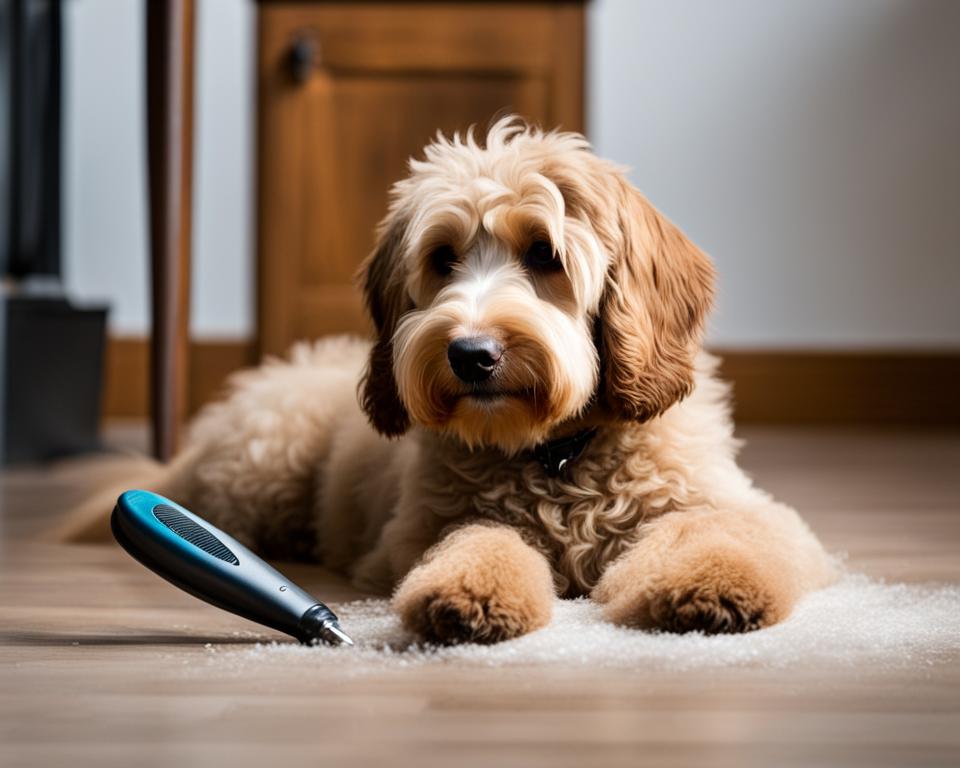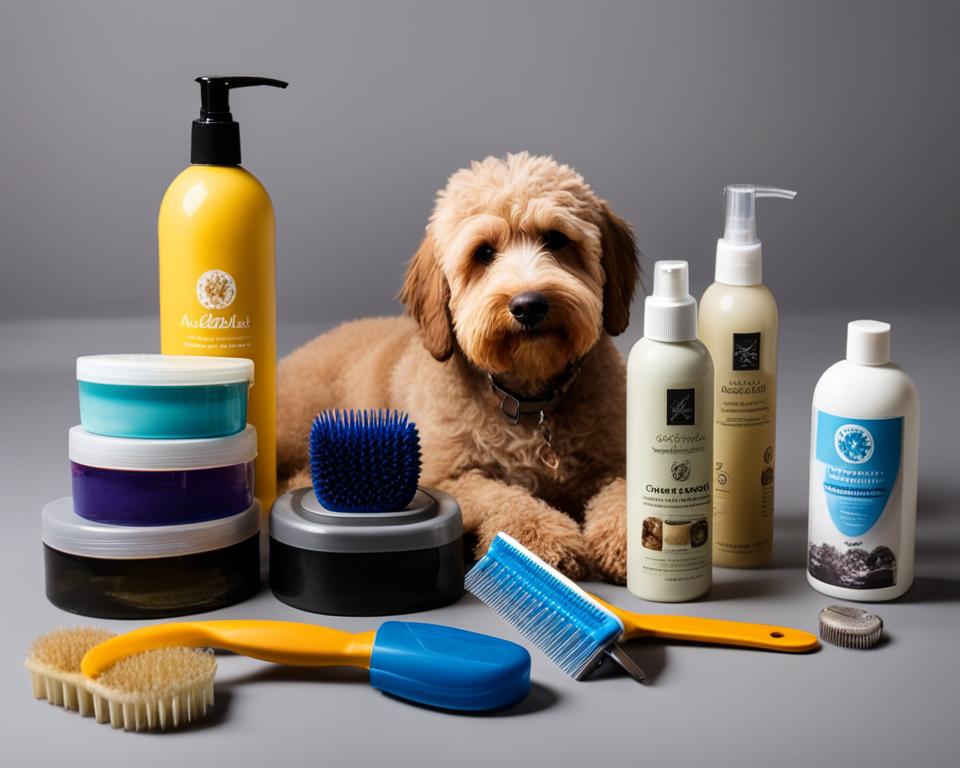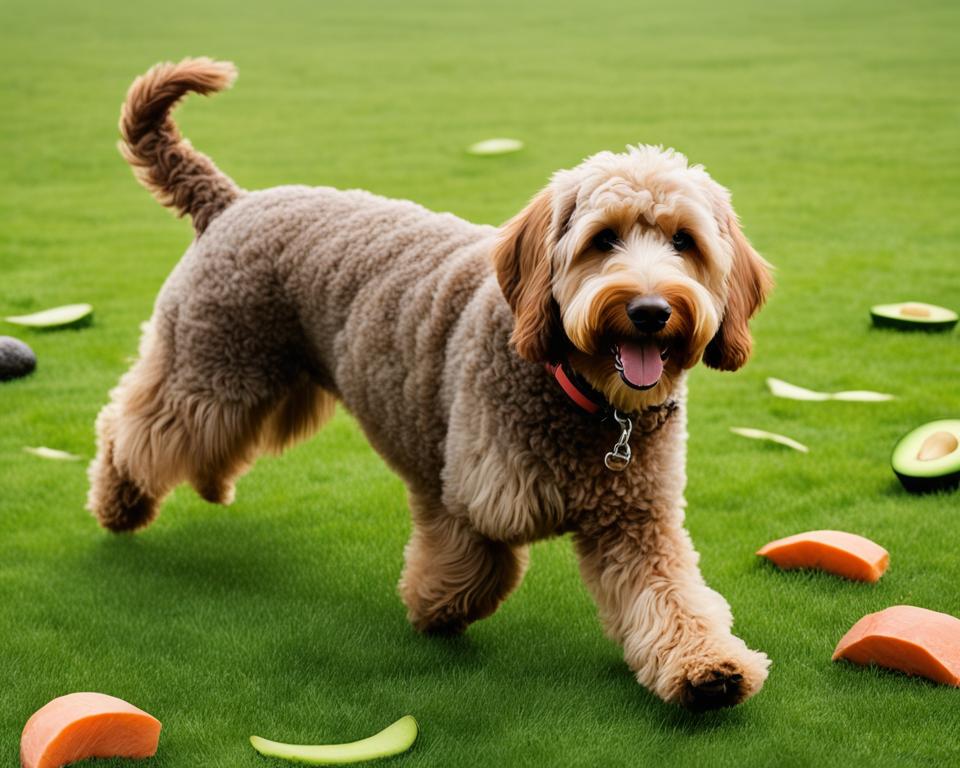Labradoodles have become increasingly popular as family pets due to their friendly nature and hypoallergenic coat. However, to keep their coat healthy and looking its best, regular grooming and care are essential. In this article, we will explore the different coat types of Labradoodles and provide tips on how to maintain their coat’s health.
Key Takeaways:
- Labradoodles have different coat types, including wool, fleece, and hair.
- Regular brushing is necessary to prevent matting, tangling, and shedding.
- Bathing should be done every two to three months using a dog-friendly shampoo.
- Professional grooming may be required depending on the coat type.
- Each coat type requires specific care, such as regular checking for matting and tangling.
Understanding Labradoodle Coat Types
Labradoodles are known for their unique coat types, which can vary significantly from one dog to another. Understanding the different coat types is essential for effectively caring for your Labradoodle’s specific needs. Labradoodles can have three main coat types: wool, fleece, and hair.
Wool Coat
The wool coat is dense and curly, similar to that of a Poodle. It is the most hypoallergenic and low-shedding coat type. Labradoodles with wool coats are often recommended for individuals with allergies or asthma. The tightly curled hair requires regular grooming to prevent matting and tangling.
Fleece Coat
The fleece coat is a mix between the Poodle’s curly coat and the Labrador’s wavy or straight coat. It has a soft and luxurious texture, making it popular among Labradoodle owners. The fleece coat can be either wavy or curly and requires frequent brushing to maintain its beautiful appearance. Regular grooming appointments are also recommended to keep the coat tangle-free.
Hair Coat
The hair coat is straight and short, resembling that of a Labrador Retriever. It is less common among Labradoodles but still seen in some individuals. Hair coats are easier to maintain compared to wool and fleece coats as they require less grooming and are prone to shedding. Regular brushing with a soft bristle brush and occasional bathing is sufficient for hair coats.
Each coat type has its own unique characteristics and care requirements. By understanding your Labradoodle’s specific coat type, you can ensure that you provide the appropriate grooming and maintenance to keep their coat healthy, beautiful, and comfortable.
Image: A Labradoodle showcasing the different coat types – wool, fleece, and hair.
Care Tips for Labradoodle Coats
Proper care and grooming are essential to maintaining a healthy coat for your Labradoodle. Regardless of the type of coat your Labradoodle has, regular brushing is key to preventing matting, minimizing shedding, and keeping the coat hypoallergenic.
Labradoodles are known for their hypoallergenic qualities, making them suitable for individuals with allergies. However, it’s important to note that proper coat care is still necessary to keep the allergens at bay and maintain a hypoallergenic environment.
To ensure optimal coat health, here are some care tips to follow:
- Brushing: Brush your Labradoodle’s coat at least once a week using a slicker brush or a comb designed for long-haired dogs. This helps remove loose hair, prevents matting, and stimulates the skin to promote healthy hair growth.
- Bathing: Bathe your Labradoodle every two to three months using a dog-friendly shampoo. This helps keep the coat clean and free from dirt and allergens.
- Regular Check-ups: Take your Labradoodle to the groomer regularly for professional grooming sessions. Groomers have the expertise to trim the coat, clean the ears, and address any specific grooming needs.
By following these care tips, you can ensure that your Labradoodle’s coat remains healthy, hypoallergenic, and free from tangles and matting.

Recommended Brushes for Labradoodles
| Brush Type | Description |
|---|---|
| Slicker Brush | A brush with fine, short wires close together. Ideal for removing loose hair, preventing matting, and detangling. |
| Comb | A comb with wide-spaced teeth. Effective for removing tangles and ensuring thorough brushing. |
| Bristle Brush | A brush with natural or synthetic bristles. Suitable for distributing natural oils and giving the coat a smooth finish. |
Bathing and Professional Grooming
In addition to regular brushing, maintaining the coat of your Labradoodle also involves regular bathing and professional grooming. While brushing helps remove loose hair and prevents matting, bathing is essential to keep your Labradoodle’s coat clean and healthy. It is recommended to bathe your Labradoodle every two to three months using a dog-friendly shampoo that is gentle on their skin and coat.
Professional grooming is also important for Labradoodles, especially considering their unique coat types. Depending on the specific needs of your Labradoodle’s coat, they may require professional grooming every few months to maintain its optimal condition. Professional groomers have the expertise and tools to trim the coat, clean the ears, and take care of other grooming needs that you might not be able to address at home.
Investing in high-quality grooming tools is also crucial for maintaining your Labradoodle’s coat between professional grooming sessions. Labradoodle grooming tools such as brushes, combs, and scissors are designed to suit different coat types and help keep their coat looking its best. Regular brushing at home not only helps keep the coat clean but also promotes healthy circulation and distributes the natural oils, giving their coat a lustrous and shiny appearance.
Grooming Tools for Labradoodles
When it comes to Labradoodle grooming tools, it’s important to choose ones that are specifically designed for their coat types. Here are a few essential grooming tools to consider:
- A slicker brush: Ideal for removing tangles and gently detangling the coat.
- A comb with both wide and narrow teeth: Helps remove loose hair and prevents matting.
- Thinning shears: Useful for blending and thinning out the coat, especially for Labradoodles with wool or fleece coats.
- Nail clippers: Essential for keeping their nails at a proper length.
- Cleaning wipes: Convenient for wiping their paws and keeping them clean.
With these essential grooming tools on hand, you’ll be able to maintain your Labradoodle’s coat at home and keep it looking its best between professional grooming appointments.
| Grooming Tool | Function |
|---|---|
| Slicker Brush | Removes tangles and detangles the coat |
| Comb with wide and narrow teeth | Removes loose hair and prevents matting |
| Thinning shears | Blends and thins out the coat |
| Nail clippers | Keeps nails at a proper length |
| Cleaning wipes | Convenient for keeping paws clean |

Specific Care for Each Coat Type
Labradoodles come in different coat types, each requiring specific care to ensure their health and appearance. Let’s explore the care needs of each coat type: wool, fleece, and hair coats.
Wool Coat Care
A Labradoodle with a wool coat has dense, curly hair similar to that of a Poodle. Regular grooming is vital to prevent matting and tangling. To maintain a healthy wool coat:
- Brush the coat several times a week using a slicker brush or comb specifically designed for long-haired dogs.
- Schedule regular professional grooming appointments to keep the coat well-maintained.
Regular grooming sessions and professional care will help keep the wool coat healthy, shiny, and free of tangles.
Fleece Coat Care
Labradoodles with fleece coats have soft and wavy or curly hair, which is a mix between the Poodle’s and Labrador’s coats. While fleece coats are relatively easy to maintain, regular brushing is still necessary to prevent matting and keep them knot-free. Here’s how to care for a fleece coat:
- Brush the coat at least once a week using a slicker brush or a comb.
- Focus on specific areas prone to matting, such as behind the ears, under the belly, and the tail.
Regular brushing will keep the fleece coat looking beautiful and minimize the risk of matting.
Hair Coat Care
Hair coats, although less common in Labradoodles, are straight and short, resembling that of a Labrador Retriever. While these coats require less maintenance, they may shed more. To care for a hair coat:
- Regularly brush the coat with a soft bristle brush to remove loose hair and prevent tangles.
- Bathe the Labradoodle occasionally using a dog-friendly shampoo to keep the coat clean and healthy.
Adequate brushing and occasional bathing will help maintain a healthy hair coat and minimize shedding.
Labradoodle Coat Type Comparison
Here’s a comparison of the care needs for each Labradoodle coat type:
table {
width: 100%;
border-collapse: collapse;
}
th, td {
padding: 8px;
text-align: left;
border-bottom: 1px solid #ddd;
}
| Coat Type | Care Requirements |
|---|---|
| Wool Coat | Regular brushing to prevent matting and tangling Professional grooming appointments |
| Fleece Coat | Regular brushing to prevent matting Focusing on specific areas prone to tangles |
| Hair Coat | Regular brushing to remove loose hair Occasional bathing to keep the coat clean |
By understanding and addressing the specific care needs of your Labradoodle’s coat type, you can ensure their coat remains healthy, tangle-free, and looking its best.
Grooming Tips for Labradoodles
Proper grooming is essential for maintaining the health and appearance of your Labradoodle’s coat. By following these grooming techniques, you can keep your Labradoodle looking and feeling their best.
Grooming Tools
When grooming your Labradoodle, it is important to use high-quality brushes and combs that are specifically designed for their coat type. The type of coat your Labradoodle has will determine the best grooming tools to use.
| Coat Type | Grooming Tools |
|---|---|
| Wool Coat | Slicker brush, metal comb |
| Fleece Coat | Paddle brush, wide-tooth comb |
| Hair Coat | Soft bristle brush, slicker brush |
Brushing Techniques
When brushing your Labradoodle, it is important to brush in the direction of hair growth. This helps to distribute natural oils and prevents debris from sticking to the coat. Regular brushing also helps to remove loose hair and prevent matting.
For Labradoodles with wool or fleece coats, it is recommended to check for matting and tangling regularly. If you notice any mats or tangles, gently work them out using a metal comb or wide-tooth comb. In some cases, trimming may be necessary to maintain the desired appearance.
Labradoodles with hair coats require less maintenance but may shed more. Regular brushing with a soft bristle brush helps to remove loose hair and keep the coat looking its best.
Professional Grooming
In addition to regular at-home grooming, it is recommended to schedule regular visits to a professional groomer. Professional groomers have the expertise and tools to trim the coat, clean the ears, and take care of other grooming needs. This is especially important for Labradoodles with fleece coats, as regular trimming and clipping help to maintain their appearance.
During your grooming appointments, be sure to communicate with the groomer about your Labradoodle’s specific grooming needs. This will ensure that they receive the proper care and attention during their grooming sessions.
By following these grooming techniques and staying on top of regular grooming routines, you can keep your Labradoodle’s coat healthy, mat-free, and looking its best.
Labradoodle Coat Care for Different Life Stages
Proper coat care is essential for maintaining the health and beauty of your Labradoodle’s coat throughout their different life stages. When they are puppies, it is important to introduce gentle brushing to help them acclimate to grooming practices. This not only keeps their coat clean and free of tangles but also establishes a positive grooming routine.
As Labradoodles grow into adolescents, their grooming needs may change. They may require more frequent bathing to keep them fresh and maintain their coat’s cleanliness. Regular brushing should continue to prevent matting, tangling, and shedding. Consistency in coat care is key to ensuring your Labradoodle’s coat remains in optimal condition.
For adult Labradoodles, regular brushing and coat care are crucial. This not only prevents matting and tangling but also helps minimize shedding, keeping your home cleaner. It is important to observe your Labradoodle’s skin during grooming sessions for any signs of issues or abnormalities. If you notice anything concerning, consult with your veterinarian for proper guidance and care.
By providing consistent coat care throughout your Labradoodle’s life stages, you can prevent common coat problems and maintain a healthy and beautiful coat. Regular brushing, appropriate bathing, and monitoring their skin health are essential steps to ensure your Labradoodle’s coat remains in top condition.
FAQ
How often should I brush my Labradoodle’s coat?
Labradoodles should be brushed at least once a week to remove loose hair, prevent matting, and maintain a healthy coat.
Are Labradoodles hypoallergenic?
Yes, Labradoodles are considered hypoallergenic, making them suitable for people with allergies. However, proper coat care is still necessary to minimize shedding and keep the coat hypoallergenic.
How often should I bathe my Labradoodle?
Labradoodles should be bathed every two to three months using a dog-friendly shampoo.
Do Labradoodles require professional grooming?
Depending on the type of coat, your Labradoodle may need professional grooming every few months. Professional groomers have the expertise and tools to trim the coat, clean the ears, and take care of other grooming needs.
What grooming tools do I need for my Labradoodle?
It is important to invest in high-quality grooming tools such as brushes, combs, and scissors to maintain your Labradoodle’s coat at home.
How should I groom Labradoodles with wool coats?
Labradoodles with wool coats require regular grooming to prevent matting and tangling. Brushing the coat several times a week and regular professional grooming appointments are recommended.
How should I groom Labradoodles with fleece coats?
Labradoodles with fleece coats are relatively easy to maintain but still require regular brushing to keep them knot-free. occasional bathing is also recommended.
How should I groom Labradoodles with hair coats?
Labradoodles with hair coats require less maintenance but may shed more. Regular brushing with a soft bristle brush and occasional bathing is sufficient for hair coats.
What is the best way to groom Labradoodle puppies?
Labradoodle puppies should be gently brushed to acclimate them to grooming practices. As they grow into adolescents, they may need more frequent bathing. Regular brushing and coat care should continue into their adult years.
What should I do if I notice any skin issues or abnormalities during grooming?
It is important to consult with your veterinarian if any skin issues or abnormalities are observed during grooming sessions. Regular veterinary care is essential for maintaining your Labradoodle’s overall health and well-being.

Leave a Reply